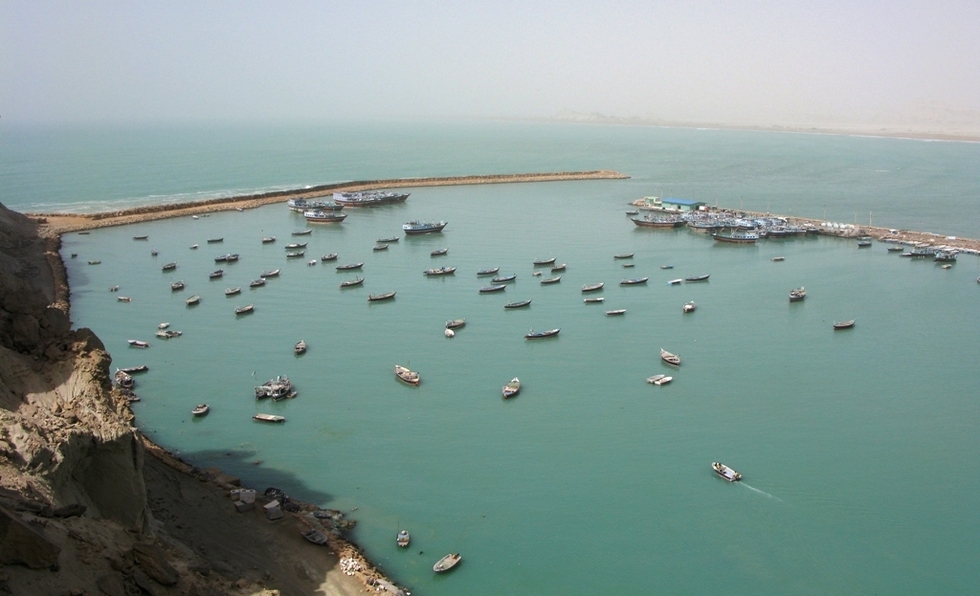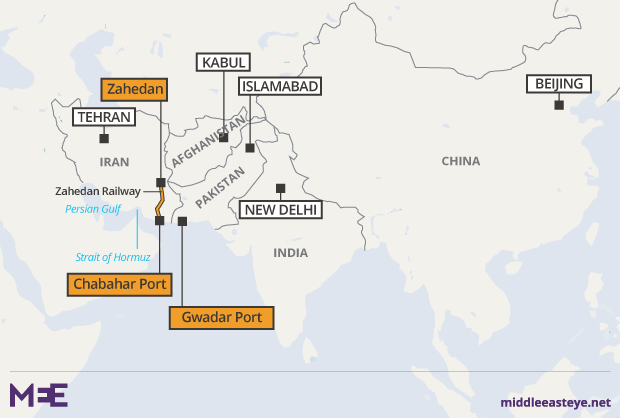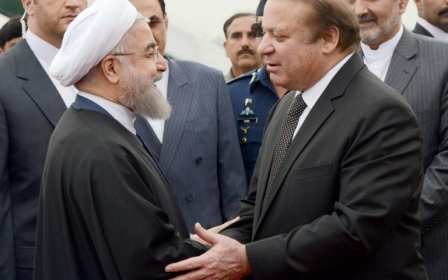A port on the Gulf of Oman: Iran’s new weapon in South Asia

Iran usually grabs headlines for its activities in the Persian Gulf and the Levant, from Iraq to Syria to Lebanon. More often than not, regional officials and observers alike point to the “axis of resistance” or, more politically, the “Shia crescent” to show Tehran’s extensive influence in the Middle East.
Yet the Gulf of Oman, Arabian Sea and more broadly South Asia is the scene of another decisive, albeit underreported, rivalry involving the Islamic Republic.
Iran’s Chabahar port, the India-funded project in the country’s Sistan and Baluchistan province, is expected to start operating in the next year or so, opening a new transit route for Afghan and Central Asian goods along with it.It will also pose a major challenge to Gwadar, the Chinese-funded Pakistani port less than 100km away – and, in a region with an already volatile balance of power, will give Tehran leverage over South Asian players.
Bypass Pakistan
Despite serious political differences with Iran over a range of enduring disputes from relations with Israel to the Kashmir conflict, India has long pursued the Chabahar port project.
In his first official visit to Tehran in May 2016, Indian Prime Minister Narendra Modi signed a three-way transit deal involving Iran and Afghanistan to turn Chabahar into a transit hub and pledged $500m for its development.
The accord will enable all three countries to bypass their rival Pakistan for convenient and reliable access to the subcontinent and the Indian Ocean.
This is particularly important for landlocked Afghanistan which has been at the mercy of Pakistan’s efforts to maintain a dominant position in the war-torn country by cultivating like-minded militant groups.
Less than 100km by sea from the Gwadar port in south Pakistan, Chabahar will also provide India with an alternative route to Central Asia, Russia and European markets, undermining perceived Chinese-Pakistani attempts to “encircle” Delhi.
"The agreement can change the course of history in this region," Modi said during the visit which he described as a “new chapter in our strategic partnership".
Iran’s balancing leverage
What makes the Chabahar port strategically important for Iran is its potential to help Tehran balance its relations with South Asia’s two nuclear-armed rivals, India and Pakistan.
Historically, the Islamic Republic has drawn on its Shia religious ideology to pressure its eastern neighbours and project influence and power over South Asian Muslims, particularly the Shia communities in Pakistan and India.
In a speech in June marking the Eid al-Fitr holiday, Iranian Supreme Leader Ayatollah Ali Khamenei pointed to the “numerous wounds” that have been inflicted on the body of the Islamic “Ummah” including the predicament of Muslims in Kashmir.
“The Muslim world should support the people of Yemen and denounce the oppressors who...are committing aggressions against them, as it should those of Bahrain and Kashmir as well,” he said.
Iran’s top decision maker in state matters - who has usually treated the Kashmir dispute with restraint to avoid irking India and emboldening Pakistan - surprisingly raised the issue once again in another address only a week later, demanding that the judiciary use legal channels and publicly declare its position on “support for Muslims of...Kashmir”.
As expected, Khamenei’s stance was welcomed by Islamabad and decried by Delhi. I argued back then that Tehran flagged up the Kashmir dispute publicly to express its dissatisfaction with Modi’s historic trip to Tel Aviv and growing ties between India and Israel, the Islamic Republic’s arch foe.
Now with Chabahar, Iran will have a “hard” geopolitical tool to influence India and Pakistan and pressure them to align their regional policies in congruence with Tehran’s interests.
War in Afghanistan
The Chabahar port and the convenient access it offers to landlocked Afghanistan through the Zahedan railway project - worth $1.6bn - also promises to strengthen Iran’s hand in the Afghan theatre.
This is of paramount importance at a time when various regional actors, from India to Russia, are striving to influence the dynamics of war in the South Asian country in their favour.
In this respect, two major objectives for Iran over the past decade have been to undermine the viability of the American military presence in Afghanistan on the one hand and contain growing Pakistani clout there on the other.
The former goal has been mostly attained in conjunction with Russia and through developing closer military and intelligence ties with the Taliban so that it could act as an Iranian-Russian proxy against the US-led mission in the Afghan war.
The latter objective, however, is being pursued by helping India, Pakistan’s prime rival, to foster a foothold in the war-torn country, and the Chabahar port in the Gulf of Oman and its planned railway connection to Zahedan – the centre of Iranian Sistan and Baluchistan province and almost adjacent to both Afghanistan and Pakistan - can prove decisive for the purpose. Indeed, it can enhance military cooperation between Tehran and Delhi at the expense of Islamabad.
Strategic depth in the Persian Gulf
Finally, the Chabahar port will allow Iran greater manoeuvrability in the Persian Gulf and Strait of Hormuz, where tense encounters occur between the Islamic Revolutionary Guards Corps (IRGC) and foreign forces from time to time.
By virtue of boosting Iran’s naval presence in the Gulf of Oman and Arabian Sea, it can furnish an operational lifeline and serve as a reliable source for logistical assistance to IRGC forces operating in the Persian Gulf, augmenting Iran’s strategic depth in that crucial area.
Apart from increasing territorial dependency on Iran for access to Central Asia, Chabahar has the potential to turn the waters north of the Indian Ocean into a maritime “sphere of influence” the type of which Tehran lacks elsewhere.
- Maysam Behravesh is a PhD candidate in the Department of Political Science and a Research Fellow in the Center for Middle Eastern Studies (CMES), Lund University. He was a senior editor of the Wiley-published journal Asian Politics & Policy and editorial assistant of the Sage-published quarterly Cooperation and Conflict. Maysam is also a regular contributor to Persian-language media outlets including BBC Persian.
The views expressed in this article belong to the author and do not necessarily reflect the editorial policy of Middle East Eye.
Image: A view from Chabahar in Iran's Sistan and Baluchestan province where an Indian-funded port project is expected to start operating in the next year or so (Flickr/Beluchistan)
This article is available in French on Middle East Eye French edition.
New MEE newsletter: Jerusalem Dispatch
Sign up to get the latest insights and analysis on Israel-Palestine, alongside Turkey Unpacked and other MEE newsletters
Middle East Eye delivers independent and unrivalled coverage and analysis of the Middle East, North Africa and beyond. To learn more about republishing this content and the associated fees, please fill out this form. More about MEE can be found here.






